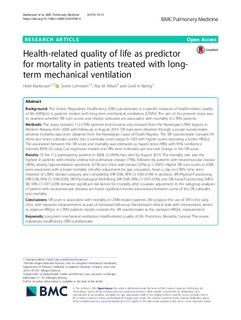| dc.contributor.author | Markussen, Heidi Øksnes | |
| dc.contributor.author | Lehmann, Sverre | |
| dc.contributor.author | Nilsen, Roy Miodini | |
| dc.contributor.author | Natvig, Gerd Karin | |
| dc.coverage.spatial | Norway | nb_NO |
| dc.date.accessioned | 2019-05-31T12:51:59Z | |
| dc.date.available | 2019-05-31T12:51:59Z | |
| dc.date.created | 2019-04-15T13:15:01Z | |
| dc.date.issued | 2019 | |
| dc.identifier.citation | Markussen, H., Lehmann, S., Nilsen, R. M., & Natvig, G. K. (2019). Health-related quality of life as predictor for mortality in patients treated with long-term mechanical ventilation. BMC Pulmonary Medicine, 19(1). | nb_NO |
| dc.identifier.issn | 1471-2466 | |
| dc.identifier.uri | http://hdl.handle.net/11250/2599573 | |
| dc.description.abstract | Background
The Severe Respiratory Insufficiency (SRI) questionnaire is a specific measure of health-related quality of life (HRQoL) in patients treated with long-term mechanical ventilation (LTMV). The aim of the present study was to examine whether SRI sum scores and related subscales are associated with mortality in LTMV patients.
Methods
The study included 112 LTMV patients (non-invasive and invasive) from the Norwegian LTMV registry in Western Norway from 2008 with follow-up in August 2014. SRI data were obtained through a postal questionnaire, whereas mortality data were obtained from the Norwegian Cause of Death Registry. The SRI questionnaire contains 49 items and seven subscales added into a summary score (range 0–100) with higher scores indicating a better HRQoL. The association between the SRI score and mortality was estimated as hazard ratios (HRs) with 95% confidence intervals (95% CI) using Cox regression models and HRs were estimated per one unit change in the SRI score.
Results
Of the 112 participating patients in 2008, 52 (46%) had died by August 2014. The mortality rate was the highest in patients with chronic obstructive pulmonary disease (75%), followed by patients with neuromuscular disease (46%), obesity hypoventilation syndrome (31%) and chest wall disease (25%) (p < 0.001). Higher SRI sum scores in 2008 were associated with a lower mortality risk after adjustment for age, education, hours a day on LTMV, time since initiation of LTMV, disease category and comorbidity (HR 0.98, 95% CI: 0.96–0.99). In addition, SRI-Physical Functioning (HR 0.98, 95% CI: 0.96–0.99), SRI-Psychological Well-Being (HR 0.98, 95% CI: 0.97–0.99), and SRI-Social Functioning (HR 0.98, 95% CI: 0.97–0.99) remained significant risk factors for mortality after covariate adjustment. In the subgroup analyses of patient with neuromuscular diseases we found significant inverse associations between some of the SRI subscales and mortality.
Conclusions
SRI score is associated with mortality in LTMV-treated patients. We propose the use of SRI in the daily clinic with repeated measurements as part of individual follow-up. Randomized clinical trials with interventions aimed to improve HRQoL in LTMV patients should consider the SRI questionnaire as the standard HRQoL measurement. | nb_NO |
| dc.language.iso | eng | nb_NO |
| dc.publisher | BioMed Central | nb_NO |
| dc.rights | Navngivelse 4.0 Internasjonal | * |
| dc.rights.uri | http://creativecommons.org/licenses/by/4.0/deed.no | * |
| dc.subject | long-term mechanical ventilation | nb_NO |
| dc.subject | health-related quality of life | nb_NO |
| dc.subject | predictors | nb_NO |
| dc.subject | mortality | nb_NO |
| dc.subject | survival | nb_NO |
| dc.subject | the severe respiratory insufficiency (SRI) questionnaire | nb_NO |
| dc.title | Health-related quality of life as predictor for mortality in patients treated with long-term mechanical ventilation | nb_NO |
| dc.type | Journal article | nb_NO |
| dc.type | Peer reviewed | nb_NO |
| dc.description.version | publishedVersion | nb_NO |
| dc.rights.holder | © The Author(s) 2019. | nb_NO |
| dc.subject.nsi | VDP::Medisinske Fag: 700::Helsefag: 800 | nb_NO |
| dc.source.pagenumber | 1-12 | nb_NO |
| dc.source.volume | 19 | nb_NO |
| dc.source.journal | BMC Pulmonary Medicine | nb_NO |
| dc.source.issue | 1 | nb_NO |
| dc.identifier.doi | 10.1186/s12890-018-0768-4 | |
| dc.identifier.cristin | 1692649 | |
| cristin.unitcode | 203,11,2,0 | |
| cristin.unitname | Institutt for helse og funksjon | |
| cristin.ispublished | true | |
| cristin.fulltext | original | |
| cristin.qualitycode | 1 | |

